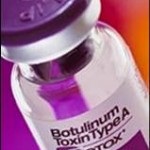
Botox, the miracle drug of the cosmetic world, is so popular for one reason…..it simply works and it works well. While its effects are not permanent, usually lasting around four months or so, it is so effective at what it does that it is a near billion dollar drug in sales for its manufacturer, Allergan.
Botox, or rather its generic name botulinum toxin from which it is derived, can cause botulism, a form of poisoning. Because botulinum bacteria produce neurotoxins, the disease brings forth images of paralysis and possible death. When I was a child, the most likely way to get botulism was from improperly canned food. Botulism bacteria in nature are encased and protected in spores. If canned food which contained any of these spores was eaten without cooking, botulism may be contracted. Proper heating of canned food kills the spores.
Botulinum bacteria produce a variety of neurotoxins, classified alphabetically from A to F. Botox is derived from toxin strain A. These neurotoxins attached themselves to the nerve endings right before they go into the muscle. Like an electric signal, the nerve endings activate the muscle by releasing a chemical neurotransmitter, acetycholine, which triggers muscle contractions. Botox works specifically by blocking release of acetylcholine from the nerve endings, essentially pulling the plug and removing the signal for the muscle to move. Historically, death from botulism poisoning was because it affected the respiratory muscles, allowing the affected patient to die from chemically-induced inability to breathe. On a much smaller scale if you paralyze a small muscle in the face, fro example, you decrease movement and hence the amount of wrinkling seen. Therein lies the difference between cosmetic Botox and deadly botulism.
Why are cosmetic Botox injections, then, not dangerous and don’t run the same risk as botulinum poisoning? Because the amount of toxin is incredibly small, diluted, and injected into a specific muscle rather than floating loose in the body. The use of Botox to treat human medical problems is not new. Since 1989, Botox has been used to treat painful muscle spasms in certain neurologic disorders and even the muscles around the eyes to treat persistent eyelid spasms. (blepharospasm) Botox was used ‘off-label’ for cosmetic facial wrinkling for years and, only in 2002, was it formally approved for these indications by the U.S. Food and Drug Administration (FDA). While it was only specifically studied for the treatment of glabellar (between the eyebrow) frowning, it can be used anywhere on the face where one wants to decrease the amount of muscle movement. The most comon area other than the glabellar region is the crow’s feet area. (wrinkling around the outside of the eyes)
Why are the effects of Botox only temporary? Obviously because the drug wears off, but it is not quite so simple at the microscopic level. The muscle movement recovers the blocked nerve endings sprout new growths called axons that bypass those nerve endings that are blocked. Like a potato in a dark closet, the nerve grows new ‘sprouts’ which cross over and reattach to the muscle…..and it begins working again…after four months or so.
Botox is now widely used for many different medical problems, most of which are due to undesired muscle activity. (e.g., migraine headaches, rectal fissures) However, Botox also appears to be effective for many problems in which nerve blockage is desired but not necessarily to a muscle. It has been a miracle cure for the problem of hyperhidrosis, excess sweating of the armpits, hands and feet. When used for these problems, the effect of Botox lasts much longer (up to a year) although it is not completely understood as to why. A newer application for Botox, although investigational at this point, is in the treatment of hypertrophic and keloid scars. Again it is not injected into the muscle but into the newly forming scar. In some cases, this has been shown to be helpful. More work is needed however before it can be claimed that it is universally effective.
Dr Barry Eppley
Indianapolis, Indiana


